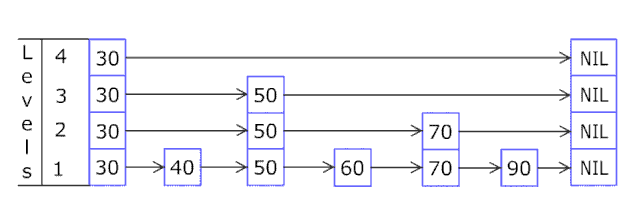跳跃表
跳表是基于链表的,在链表的基础上加了多层索引结构。
跳表这种特殊的数据结果是有 Willam Pugh 发明的。最早出现在1990 年发表的论文《Skip Lists: A Probabilistic Alternative to Balanced Trees》
论文中有个描述:
Skip lists are a data structure that can be used in place of balanced trees.
Skip lists use probabilistic balancing rather than strictly enforced balancing and as a result the algorithms for insertion and deletion in skip lists are much simpler and significantly faster than equivalent algorithms for balanced trees.
简单的说,跳表是基于概率型的表。
先看个普通有序链表的结构:

如果要查找 23 那么起码需要比较 2次,查找 43 比较 4次,查找 59 比较 6次。有什么办法解决这个问题呢?容易想到二分搜索。
采用分层链表结构,以一些节点作为索引,


比如,提取了 14 34 50 72 作为一层链表,查找 59 的时候,就可以通过比较 14 24 50 59 共5次找到 59 来减少查找次数。
如果加一层,基本上就可以采用类似二分的方式进行查找了


现在看给完整的 快表插入一个新元素的过程:

参考代码:
public class SkipList {
private static class SkipListNode {
int data;
SkipListNode[] next;
SkipListNode(int d, int level) {
data = d;
next = new SkipListNode[level + 1];
}
}
private int maxLevel;
SkipListNode header;
private static final int INFINITY = Integer.MAX_VALUE;
SkipList(int maxLevel) {
this.maxLevel = maxLevel;
header = new SkipListNode(0, maxLevel);
SkipListNode sentinel = new SkipListNode(INFINITY, maxLevel);
for (int i = 0; i <= maxLevel; i++)
header.next[i] = sentinel;
}
public boolean find(int key) {
SkipListNode current = header;
for (int i = maxLevel; i >= 0; i--) {
SkipListNode next = current.next[i];
while (next.data < key) {
current = next;
next = current.next[i];
}
}
current = current.next[0];
if (current.data == key)
return true;
else
return false;
}
public void insert(int searchKey, int newValue) {
SkipListNode[] update = new SkipListNode[maxLevel + 1];
SkipListNode current = header;
for (int i = maxLevel; i >= 0; i--) {
SkipListNode next = current.next[i];
while (next.data < searchKey) {
current = next;
next = current.next[i];
}
update[i] = current;
}
current = current.next[0];
if (current.data == searchKey)
current.data = newValue;
else {
int v = generateRandomLevel();
SkipListNode node = new SkipListNode(newValue, maxLevel);
for (int i = 0; i <= v; i++) {
node.next[i] = update[i].next[i];
update[i].next[i] = node;
}
update = null;
}
}
private int generateRandomLevel() {
int newLevel = 0;
while (newLevel < maxLevel && Math.random() < 0.5)
newLevel++;
return newLevel;
}
public boolean delete(int searchKey) {
SkipListNode[] update = new SkipListNode[maxLevel + 1];
SkipListNode current = header;
for (int i = maxLevel; i >= 0; i--) {
SkipListNode next = current.next[i];
while (next.data < searchKey) {
current = next;
next = current.next[i];
}
update[i] = current;
}
current = current.next[0];
if (current.data == searchKey) {
for (int i = 0; i <= maxLevel; i++) {
if (update[i].next[i] == current) {
update[i].next[i] = current.next[i];
current.next[i] = null;
} else
current.next[i] = null;
}
return true;
}
return false;
}
public static void main(String[] args) {
}
}关注公众号:【程序员开发社区】






















